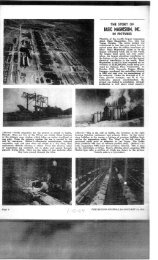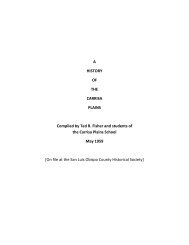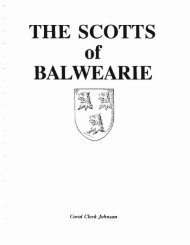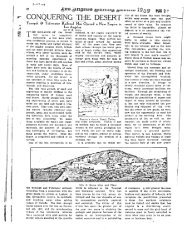1940 - part 2 - Vredenburgh.org
1940 - part 2 - Vredenburgh.org
1940 - part 2 - Vredenburgh.org
Create successful ePaper yourself
Turn your PDF publications into a flip-book with our unique Google optimized e-Paper software.
.,<br />
WILLIAM CARNIE. JR •• * reports<br />
War Demands Boos~<br />
ALTHOUGH domestic quicksilver prt>duetion<br />
has more than doubled in the<br />
last year, United .States mine operators<br />
must increase their output still further if<br />
they are to meet the demand created by<br />
Europe's war.<br />
Basis for this prediction is the fact that.<br />
with Spain apparently falling in line with<br />
the Axis powers, United States mines probably<br />
will be called upon to supply not only<br />
heightened domestic needs, but those of the<br />
British empire as well.<br />
During the 10 years ending with 1937,<br />
consumption of quicksilver in the United<br />
States was approximately 28,000 flasks annually,<br />
and judging by the experience of<br />
the last World War, a step-up of ahout onethird<br />
in domestic needs can be expected<br />
during the national preparedness program.<br />
According to U. S. Bureau of Mines figures,<br />
the consumption of quicksilver in the<br />
United States during the war years of<br />
1917 and 1918 jumped 38 per cent over<br />
the preceding five-year average.<br />
Virtually without quicksilver resources<br />
of her own, the British empire has in recent<br />
years relied heavily upon imports from<br />
Spain. During 1936, 1937, and 1938, Spanish<br />
exports to the United Kingdom totaled<br />
116,679 flasks, an average of 38,893 flasks<br />
a year. Loss of this source of supply must<br />
mean that Britain can look only to the<br />
United States for her quicksilver needs.<br />
Normally, Spain and Itsly have produced<br />
roughly 70 per cent of the world's quicksilver<br />
supply while the United Ststes ranked<br />
third, contributing about 15 per cent of the<br />
world tots!, In 1938, the Italian quicksilver<br />
output was 66,719 flasks j Spain produced<br />
an estimated 40,000 flasks; and<br />
United Ststes production was only 17,991<br />
flasks. Mexico ranked fourth with 8,619<br />
flasks; the Russian yield, for which figures<br />
are not available, probably was about the<br />
same as Mexico's ; and other production<br />
throughout the world was relatively unimportsnt.<br />
During the last year, however, the U. S.<br />
picture has changed completely. Production<br />
figures have followed closely the skyrocketing<br />
prices which, by mid-October,<br />
had nsen to $176 a flask as compared to<br />
slightly more than $70 a flask in 1938.<br />
With numerous new properties going on<br />
production and producing mines stepping<br />
up operations, the domestic output has shot<br />
upward. Current estimates for " the <strong>1940</strong><br />
U. S. yield are 38,000 flasks.<br />
C li)~" individual producer of quicksilver<br />
in the United Ststes is H. W. Gould and<br />
Company, 1000 Mills Building, San Franeisco,<br />
which operates six mines in California<br />
and Nevada, now accounting for approximately<br />
one-third of the total domestic<br />
output. The New Idria mine in San Benito<br />
*Sem Frcmciaco, CalUornict.<br />
Iinprovemenls in nunmg methods<br />
and recovery equipment have<br />
made possible the treatment of<br />
ore~ with an average quicksilver<br />
content 01 0.4 per cent. compared<br />
to the 10 per cent ore treated in the<br />
bonanza days 01 quicksilver mining<br />
in the United States. Esti·<br />
mates lor <strong>1940</strong> indicate that U. S.<br />
production 01 quicksilver this year<br />
will more than double that 01 1938.<br />
County, California, largest of the Gould<br />
group, rates as the greatest single producing<br />
property in the western hemisphere,<br />
yielding an average of 550 flasks a month.<br />
Here, 250 men are employed under the direction<br />
of Superintendent C. Hyde Lewis,<br />
and the two special rotary furnaces of the<br />
recovery plant are burning 450 tons of ore<br />
daily. In additiorl to newly mined ore, a<br />
large tonnage of material from the dumps<br />
A general view of the upper camp at the<br />
New Idria mine in San Benito County, California,<br />
operated by H. W . Gould and Company.<br />
All ore mined from the .. lory hole<br />
or from tunnels at the upper camp is transported<br />
by means of • gravity-operated cable<br />
tram to the lower camp where the reduction<br />
\lnit i, situated.<br />
Quicksilver Ou~pu~<br />
of early-day operators is being treated.<br />
Henry "Gould, company president, reports<br />
that with present equipment a recovery of<br />
98 per cent is possible. Pioneer quicksilver<br />
miners were fortunate to recover more<br />
than 60 per cent of their values.<br />
Development work at New Idria is being<br />
pressed in the No. 10 tunnel which, Gould<br />
states, will be opened for a distance of<br />
7,000 feet.<br />
Other Gould properties in California include<br />
the Helen mine in Lake County<br />
where lessees are busy reopening the old<br />
underground workings preparatory to placing<br />
it on production early next year; the<br />
Oat Hill mine in Napa County, now producing<br />
from 125 to 150 flasks a month;<br />
and the Klau mine in San Luis Obispo<br />
County, where 40 men are employed and<br />
the 176-foot shaft is being deepened to<br />
400 feet.<br />
Completing the Gould group are the Wild<br />
Horse quicksilver and Mt. Tobin mine in<br />
Nevada. Both properties are small-scale<br />
operations, each handling 20 tons of ore<br />
daily.<br />
Probably the most important new development<br />
in the nation is the reopening of<br />
the famed New Almaden mine in Santa<br />
Clara County, California. Work at the<br />
property, once the fourth largest producing<br />
mine in the world, was started in 1939<br />
by the New Almaden Corporation of PhIladelphia,<br />
Pennsylvania. C. N. Schuette, 533<br />
Call Building, San Francisco, is engineer<br />
in charge. Although only a email amount<br />
of surface work has been done in recent<br />
years, the New Almaden has produced<br />
more than one million flasks of quicksilver,<br />
or about half the total production of California,<br />
during its history.<br />
UST what will be the maximum yield<br />
J attained by U. S. mines during the war<br />
emergency is still unpredictable, but it is<br />
interesting to note that this country once<br />
led the world in quicksilver production.<br />
The top domestic output was reached in<br />
1877 when the nation's mines turned out<br />
some 80,000 flasks, or about two-thirds of<br />
the world's total.<br />
Drastic curtailment of U. S. production<br />
was brought about by a rapid falling off<br />
of values in the major quicksilver areas.<br />
In the early 1890's, the average ore mined<br />
in this country contained only about 1 per<br />
cent quicksilver instead of up to 10 per<br />
cent as it had during the peak days of the<br />
1870's. Bureau of Mines figures now give<br />
the average content as 0.4 per cent.<br />
Improvements in mining methods and recovery<br />
equipment have largely offset this<br />
drop in values, but low prices kept production<br />
down during the last 20 years. Spanish<br />
and Italian mines, oper:l.ting with cheap<br />
labor on reasonably high-grade ore, (Spanish<br />
ore runs 5 to 7 per cent quicksilver), "<br />
rHE 'MINING JOURNAL tor.,vOVEMBER 15, <strong>1940</strong><br />
Page -$















